
In this paper, we report findings from a larger study that investigated design failure, as a phenomenon, in instructional design (ID) practice from the perspective of ID practitioners. Following an interpretive phenomenological study design, we interviewed 17 ID practitioners working in diverse settings, seeking their stories of design failure. Throughout the interviews and the analysis of the practitioners’ stories of design failures, we found that ID practitioners define design failure in different ways that are mostly not captured in design literature, that is: design failure as “failure during use of design,” design failure as “failure during process of design,” design failure as “an opportunity for reflection on design actions,” design failure as “an outcome or an event that needs to be avoided/prevented during the process of design,” and design failure as “an outcome or an event that could not be avoided/prevented during the process of design.” These findings and our discussions of them emphasize the generative role design failure plays in ID practice, the richness and the complexity of this phenomenon, and point to implications for IDT scholarship and ID education. In an upcoming paper, we report what ID practitioners attribute design failure to and what is the essence of design failure in ID practice.
This is a preview of subscription content, log in via an institution to check access.
Price includes VAT (France)
Instant access to the full article PDF.
Rent this article via DeepDyve
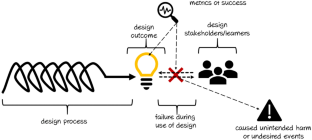
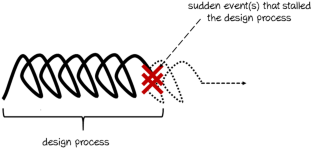
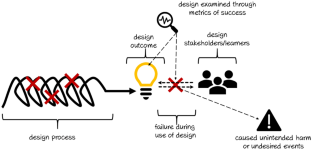


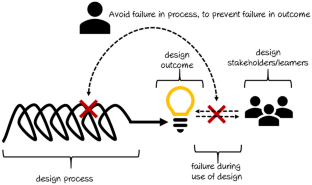
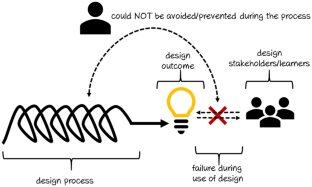

Springer Nature remains neutral with regard to jurisdictional claims in published maps and institutional affiliations.
(Instructional Designer, Non-Profit Governmental Organization|25 years of ID experience).
Kathy shared a story of an eLearning design project in which the final product (i.e., the eLearning course) was not adopted by instructors and other stakeholders in her work organization. From her perspective, not adopting and using what she designed is an “ultimate” design failure, specifically when an eLearning course she designed ends up as “shelf ware”—a design that ends up on the shelf with no one using it. Kathy spoke about the causes of this design failure, such as the lack of buy-in from instructors and the subject matter experts (SMEs) she works with, the organizational structure of her workplace that gives her a limited design role, the overall methods of project management in her work organization, and instructors perceiving her work as threatening to their teaching practices and job safety. Kathy spoke of the importance of treating these causes of design failure—mainly the buy-in from instructors and content validation from SMEs—early in the design process to ensure adoption at the end, thus, ensure design success. She shared how experiencing design failure prompted her to reconsider her design process and employ methods to treat the same causes of potential design failure.
(Instructional Designer: Non-Profit, Governmental Organization|23 years of ID experience).
Kevin shared a story of a software training, designed and developed by the same company that designed a software and sold it to his work organization. He described the training as a design failure because, when employees started to use the software, the software company’s help desk was overwhelmed with support requests. From his perspective, the training failed to teach employees in his organization what they needed to do with the software. As it was not his design work, Kevin commented how the software company was not able to understand how their training failed, so he stepped up to examine the training, analyze causes of design failure, and offer solutions to fix the training. He spoke about the causes of this design failure as the design choice to include too much information, how the training lacked relevant knowledge for the employees, and the fact that the training was rolled out to employees three months before they needed to use the software. Additionally, Kevin commented on other design failures that he experienced himself, particularly when he engaged in design projects prompted by an “executive” order, not an actual learning and/or performance need for employees. Such design projects, per Kevin, either did not finish when the executive who issued the “design order” role left the work organization or ended up being implemented with no other impact than “wasting people’s time.” Kevin shared how experiencing these design failures in frequent manners allowed him to spot design failures in other designs easily and to establish micro-learning strategies to design training.
(Sr. Director, Learning & Development: Non-Profit Civilian Organization| 30 years of ID experience).
Amanda shared a story of a design project in which she led the design of a training on a new software her company was launching. She described the project as a design failure because she was asked to design the training without access to the software itself, instead designing it based on the early versions of design documents of the software. From her perspective, design failure was inevitable since it started at the process of the design and eventually turned to a failed design outcome—that is, the training did not help employees to learn and to support the new software. Amanda stated that she expected this design failure and warned against it, yet she was asked by her managers to design the training anyway. She commented how she planned for the inevitable design failure by starting to draft job aids that could be easily updated as the software got updated. Amanda spoke about the causes of this design failure, such as managers in her workplace not prioritizing design, time constraints, and the overall managers’ views and opinions about design.
Additionally, and without sharing a specific story of a design project, Amanda spoke about how design failure is something to be assessed only through a specific measure of success: mastery of a skill demonstrable upon completing the training through a test. From her perspective, a trainee who passes a test upon the completion of a training but does not transfer what they learned to their job is not a measure of design failure. Amanda stated that performance on the job is not the scope of instructional design but rather the scope of “performance consulting.” With that said, a trainee failing to master a skill through training is design failure because mastery of skill is the measure of success for design, not the transfer of skill. Per Amanda, the cause of this design failure is the designer’s ability to make solid design decisions about instructional strategies and learners.
(Instructional Design Consultant, Independent Consulting for Corporate | 17 years of ID experience).
Tiffany shared three stories of three design projects she was involved in. The first story was about a design project she was brought to as an external consultant to investigate and fix a problem in the design that the client noted. From her perspective, it was a design failure because the client was not satisfied with what other designers had designed. She spoke about two causes of this design failure: designers not employing appropriate design methods to document what they did and designers’ failure to establish a continuous dialogue with the client about the design work.
The second story was about a job aid employee training she was asked to design and develop a portion of. She considers it a design failure because she thought what she designed and the overall training would not serve the client’s needs. Particularly, she designed the job aid without knowing information about its purpose and how it would be used. She spoke about the causes of this design failure as clients deciding what they need without consulting with designers, and designers following the lead of the client without asking questions or establishing a dialogue about the need for a design as a solution.
The third story was about a design project of an eLearning employee training that she carried out from the beginning among other designers and consultants. From her perspective, the eLearning training was a design failure because learners rated it negatively after completing it. Tiffany spoke about the causes of this design failure as designers’ failure to act on the results of the analysis they conducted, following clients’ lead to deliver what they wanted despite what they needed and designing something that was not actually needed by the learners.
Tiffany shared how experiencing this design failure prompted her to emphasize the importance of some crucial design methods, such as learners’ analysis and problem framing with clients. Most importantly, she spoke about the importance of a designer’s capacity to make a “conscious decision” that can guide the client to what they need and not what they want.
(Instructional Designer, Independent Consulting: Corporate | 6 years of ID experience).
Jane started the interview by stating that oftentimes, after she designs and develops a course, she does not get to see an evaluation of what she designed. This evaluation would tell her whether what she designed failed or succeeded. Then, she shared a story of an eLearning training for flight attendants that she developed and contributed to its design. She developed 24 modules using Adobe Captivate software and ran the training through testing. She described the training as a design failure because learners had issues with accessing the course content through their mobile devices. From her perspective, it was a design failure even though the failure was related to user experience and technical issues and not related to instruction or course content per se. Jane spoke about the causes of this design failure, such as previous design decisions that she was not involved in, not being able to foresee a specific technical issue, the lack of rigorous user testing and the limitation of testing as a design method in general—that is, user testing could not uncover all of the problems a design could have. Additionally, Jane spoke about how a project failure to launch or a stall in design process is not a design failure but rather a “project management failure.” In her view, the design process ought to finish first and result in a design outcome for learners to use before design failure can occur. She shared how experiencing this design failure allowed her to learn about the value of empathy with learners: not only knowing the target learners but also knowing their environments and the type of devices they use to access the training she designs.
(Instructional Design Consultant: Independent Consulting, Corporate | 25 years of ID experience).
Claire shared a story of a design project that was “scrapped” by her client early in the design process. The project was canceled by a CEO of the company that hired her, even though she was asked to start the design project by the Vice President of the same company. She described the design project as a design failure because the process did not finish and there was not enough support for it, financially and politically. From her perspective, having a design process oriented toward stakeholders is a successful design project. Claire talked about how a design project that is finished, implemented, and negatively evaluated by learners is not necessarily a design failure. From her perspective, getting feedback about areas to improve the design is part of the design. However, it could be a design failure if a designer was not receptive to feedback and did not want to improve the design. Claire spoke about the main cause of this design failure as her inability to secure support for the design process. She also noted other possible causes of design failures that she did not experience per say but could see happening, such as designers not including design stakeholders in the design process, refusal of designers to listen to different ideas and feedback on their design, designers centering the design process around themselves, and designers’ general way of thinking about their design ability. Claire shared how experiencing design failure taught her to always make sure that there is full support for her design process and how important it is to conduct regular check-ins with stakeholders to make sure everyone is on the same page.
(eLearning & Instructional Design Consultant, Independent Consulting | 20 years of ID experience).
Bob shared a story of a design project that he led that involved designing training for bus drivers. The training was designed to be delivered through cellphones and text messages. From his perspective, having learners opting out from receiving text messages, thus opting out from the training, constitutes a design failure—an undesirable outcome that he could not fix. Bob had implemented “measures of design success” from the very beginning, including an increase in passing rate among bus drivers between 25 and 40%. When he saw the pass rate declining as the training was being implemented, he found that more than 90% of bus drivers opted out from the training program and its cellphone/text message-based format. He spoke about the causes of this design failure, such as the annoying quality of the training he designed, his and his team’s capacity to foresee all issues that could appear with the design, the constraints caused by default and forced on design features that were out of his control, the limitations of instructional design best practices, and the lack of his ability to empathize with the learners. Bob shared how experiencing this design failure was a critical moment in his design career and how it prompted him to rethink how to do design in the future, such as employing more human-centered design approaches and conducting rigorous user testing.
(Instructional Designer, Higher Education | 8 years of ID experience).
Arthur shared a story of an online course design project that was not completed on time. The course design process was a collaborative effort among the faculty members who would be teaching the course and himself as the instructional designer. From his perspective, not finishing the course design in a timely manner—and a few weeks before it is going to be offered for the students—was a design failure. Additionally, he stated that “problems” with (designed) online courses occurring after the design process is complete often times cannot be considered as a design failure. Per Arthur, it is the instructor’s role to ensure the success of the delivery of the course design, or it is the SMEs’ role to ensure rigor and appropriate course content. He articulated a metaphor in which he is like an air traffic controller, and his role is to have the airplane (the course design) take off safely from the airport. After that, it is the flight crew’s (the instructor and other SMEs) role to safely fly the airplane. Arthur spoke about the causes of this design failure, such as the faculty collaborators not doing their required part of the design work or doing poor quality design work, the faculty collaborators’ lack of understanding of how the design process should be carried out, organizational structure and human resource management, time constraints, faculty collaborators not respecting the design process he had in place, and his lack of ability to make design decisions early enough in the design process. He spoke about the causes of design failure as signs or symptoms of inevitable failure that appeared throughout the design process. Arthur shared how experiencing this design failure prompted him to reconsider his design process—mainly by.
(Senior Instructional Designer, Higher Education|10 years of ID experience).
Gomom shared a story of an online course design project that was too challenging to carry out, and, eventually, the result was an online course that was not implemented in the way it was designed. The course design process was a collaborative effort between the faculty member who would be teaching the course in an online and face-to-face format and herself as the instructional designer. From her perspective, design failure is a “strifeful” design process that she was able to “push through” and, in this case, was a course being implemented/taught contrary to the way she designed it. Gomom spoke about the causes of this design failure, such as the professional character of the faculty collaborator, not being able to reach consensus with the faculty member regarding major design decisions, the organizational structure of her workplace, the common misunderstanding of her design role and her capabilities among faculty collaborators, and the limited role that she plays in her design work. She shared how experiencing this design failure prompted her to work more closely with other designers in her unit to be united in terms of methods of design work, sharing suggestions and strategically employing different design processes that work with different “mindsets” of faculty collaborators.
(Educational Development Specialist, Higher Education| 24 years of ID experience).
Kelly shared a story of a project on which she worked as the lead designer to develop a training program for a governmental organization. She described the project as a design failure because the client—the governmental organization—conducted a training program evaluation. Although the client deemed the overall training to be successful, Kelly focused on the two parts of the evaluation report that highlighted that learners were not satisfied with the training program she designed and that learners did not learn knowledge and skills relevant to their profession. She stated that the client did not get what they needed in terms of training needs, but they got what they asked for in terms of training content and format. From her perspective, a client getting what they asked for and asking whether learners learned something or not are not appropriate measures of success in design. Rather, it is whether learners are going to make the world different after they learned something, therefore, determining if learning matters to the learners. Kelly spoke about the causes of this design failure, such as the client refusing to let designers employ appropriate analyses, availability of SMEs, and client making decisions regardless of what designers recommended. Kelly shared how experiencing this design failure prompted her to reflect on her professional character, thus separating herself as a person from her professional personality as a designer so that she could recognize that other people have different measures of design success/failure than she does.
(Learning Designer: Higher Education | 30 years of ID experience).
Andrew shared a story of a design project in which he led the design of an online course. He described the project as a design failure once he found out that no design stakeholder could validate the content of the course he was asked to use as a design asset. From his perspective, it was a design failure because the design project did not finish and was cancelled in the middle of the design process. Andrew stated how this design failure was hard to conceive since it occurred for “non-technical reasons.” He spoke about the main cause of this design failure as too many design stakeholders did not want to take ownership of the course content, thus refusing to validate his early design drafts. Additionally, and without sharing a specific story, Andrew spoke about other types of design failure that he recognizes—that is, when a course fails to meet learners’ needs. This type of design failure, per Andrew, does not mean the end of the design but instead offers an opportunity for a new design iteration and an opportunity to continuously improve what was designed. If this happens, the cause of this design failure is shared among the designer and other stakeholders who make critical design decisions as much as the designer does. Andrew shared how experiencing design failure allowed him to reconsider his design approach and view, mainly by broadening the scope of his analysis method, including elements beyond learners and learning, such as design stakeholders and identifying the type of collaboration he needs to have with design stakeholders. Additionally, Andrew spoke about how he embeds formative evaluation of design throughout the design process to make multiple points for checks against design failure, such as user testing and rounds of design iterations.
(Instructional Designer: Higher Education|30 years of ID experience).
Jake shared a story of a time when he examined the student evaluation of an online course design because students had complained about the course and the instructor of the course. He described this online course as a design failure because the course had low quality learning materials and lacked communication and engagement between the students and the instructor. Jake pointed out that he did not design the course, nor was his unit ever aware of the online course offering because neither the department chair nor the instructor followed the initialization process of online course design and offering. He spoke about the cause of this design failure as the overall administrative system that failed to prevent an online course design and offering from happening without his design unit’s consultation, the lack of his design capacity to enforce the design process he had in place, and the inexperience of the instructor with online course design and teaching. Additionally, Jake spoke about how a stalled or unfinished design project is not a design failure since problems happening at the process of design will lead to design process success. From his perspective, figuring out failure at the process level is not design failure; it is similar—using his own words— to what Thomas Edison said: “I didn’t fail 100,000 times; I just learned 100,000 ways not to make a light bulb.” Jake commented on how experiencing design failure prompted him to advocate for his design unit with the college’s leadership in order to gain more leverage in designing online courses and to collaborate effectively with faculty in designing and teaching online courses.
(Instructional Designer Consultant, Corporate | 19 years of ID experience).
Bravo started the interview by stating that she rarely gets to know whether what she designed was a success or a failure. On a few occasions, she got to know how her design was successful when she was able to access some metrics that indicated learner’s success rate in passing licensing exams after completing courses she designed. She also shared two stories of design projects that were not completed and where she experienced challenging design processes. However, Bravo was clear to state that she classifies these un-finished (and never completed) design projects as “project failures” and not “design failures.” From her perspective, design failure occurs after a project is completed and the design went to learners and when there are metrics or feedback that indicate learning failure. Bravo talked about how a design failure can occur while she is engaged in the design process by sharing the following hypothetical scenario: a client prevents her from employing instructional design strategies that aim to maximize learning success. She spoke about the causes of this hypothetical design failure, such as when the client’s values oppose what is best for learners, her limited capacity to control the design process, and the overall client-driven/client-centered design approaches of her work organization. Bravo also emphasized that she always feels in need of more information about how her design is working for learners and for more feedback on the training she designed from clients after they implemented what she designed. For her, as long as she does not receive this information, she feels that she cannot improve her design processes.
(Instructional Design Consultant: Corporate | 40 years of ID experience).
Fred shared a story of a project in which he designed training for employees at a supply chain management company. He collaborated with external developers who were tasked to develop the instructional and learning materials of the training. He described the project as a design failure when he found—during the trial/testing session—that the course was developed without the course objectives and the performance-based training strategy he designed and envisioned. Since this design failure was uncovered during the trial/testing stage, Fred talked about how he was able to re-launch the design process and turn the failed design training into a successful design by the time it was rolled out to learners. He spoke about the causes of this design failure, such as him not being specific and clear enough about his expectations from the developers he hired and not monitoring the development process of the training he designed. Additionally, Fred shared another story of design failure in which a course he designed passed “all checkmarks” and was rolled out to employees. Per Fred, the course failed because the instructor was not happy with the design of the course and did not buy into it. Fred emphasized that, while design failure and/or success must be assessed through a four-level training evaluation, this design failure did not occur due to the design element he was responsible for. He spoke about the causes of this failure as mainly the instructor not implementing the design the way it was designed. Fred shared how experiencing design failure allowed him to improve his way of design, mainly in project planning, communicating clear expectations, writing clear strategy statements, and being more immersed in the design project.
(Instructional Designer: Corporate|5 years of ID experience).
Harper shared a story of a project in which she designed a training for sales representatives at a technology company. She described the whole design project—process and outcome—as a design failure. From her perspective, the complicated process of design—in which she had too many stakeholders making decisions that resulted in too many design iterations—eventually led to a training that was not functional and not well received by sales representatives. Harper mentioned that she expected the design outcome to fail because the failure started in the process of design. She even explained how she planned for this design failure and made it “a soft-landing failure” in order to prevent bigger issues from happening. Such planning required her to make back-up plans for other designs. Even though she predicted and warned about this design failure, Harper spoke about the causes of this design failure, such as the way the design process was executed and managed in her workplace and the male-dominated culture of her workplace that made her feel powerless and disrespected. She shared how experiencing design failure allowed her to reconsider how she carries the design process, to have better stakeholder management, to set the table stakes for roles, tasks, and timeline, and to form an agile team without letting the executives have much say or ability to see into the design project.
(Learning & Design Manager, Corporate|21 years of ID experience).
Natalie shared a story of a training evaluation project in which she examined existent training at a company where she got hired as a designer. This company wanted to evaluate the trainings they had designed already in order to assess their value against the costs of design. She described the training she was asked to evaluate as design failure because she found that learners thought of the training as “fancy” but not useful and because the training format did not fit their working environment. Also, the design of the training had some quality issues in terms of media accessibility. Thus, the training had a low value despite its high design cost. Additionally, Natalie commented that a design project stalling at the process level or not completing a design project cannot be classified as design failure because the causes of project stall or incompletion are outside of the design scope. From her perspective, a design project has to finish and the design outcome needs to be evaluated to determine whether it was a design failure or success. Natalie spoke about the causes of design failure, such as the lack of proper analysis of learners, their environment, and their needs, the lack of a learner/user-centered approach to design, the fact that design projects in her company are initiated by design stakeholders with no background in design, and how design projects are executed by individuals who were not trained as designers. She spoke of how experiencing this design failure taught her the importance of analysis and to fight for a design approach that emphasizes user-centered values. Natalie stated that she continues to advocate for a user-centered design approach despite being laid-off from a previous employer when she did so.
(Instructional Designer: Corporate|6 years of ID experience).
Elizabeth shared two stories of two design projects in which she led the design efforts and deemed both to be design failures. The first story was about an eLearning training on a software that involved the design of simulations. It was during the draft review of the design when Elizabeth realized it was a design failure before she delivered the final product. From her perspective, the design failed at the process level because what she designed was not validated by all stakeholders of the design. Elizabeth spoke about a main cause of this design failure as not being able to, first, identify all stakeholders of the design and, second, not being able to include the unidentified stakeholders in her design process.
The second story was about a webinar training that she designed and was tasked to deliver. After successfully completing the design process of this webinar training, it was after delivering the webinar when Elizabeth realized it was a design failure. From her perspective, the design failed because learners’ and stakeholders’ expectations were not met. The learners who took the training stated that the information was not relevant and/or inaccurate, and stakeholders, such as SMEs, disagreed with the way the content of the training was presented. Elizabeth spoke about the causes of this design failure—which she actually expected—as not being able to do quality work within a tight time frame, her inability to push back against wrongful decisions from her work supervisors, and the overall corporate culture that emphasized quantity of work and not quality.
Elizabeth shared how experiencing these design failures allowed her to reconsider how to approach her supervisor’s decisions that she disagrees with and to find good ways to involve all possible stakeholders early in the design process.
Springer Nature or its licensor (e.g. a society or other partner) holds exclusive rights to this article under a publishing agreement with the author(s) or other rightsholder(s); author self-archiving of the accepted manuscript version of this article is solely governed by the terms of such publishing agreement and applicable law.
Lachheb, A., Boling, E. How do they define design failure? An investigation of design failure in instructional design practice from the practitioners’ perspective. Education Tech Research Dev 72, 687–725 (2024). https://doi.org/10.1007/s11423-023-10329-7
Anyone you share the following link with will be able to read this content:
Get shareable link
Sorry, a shareable link is not currently available for this article.
Copy to clipboard
Provided by the Springer Nature SharedIt content-sharing initiative